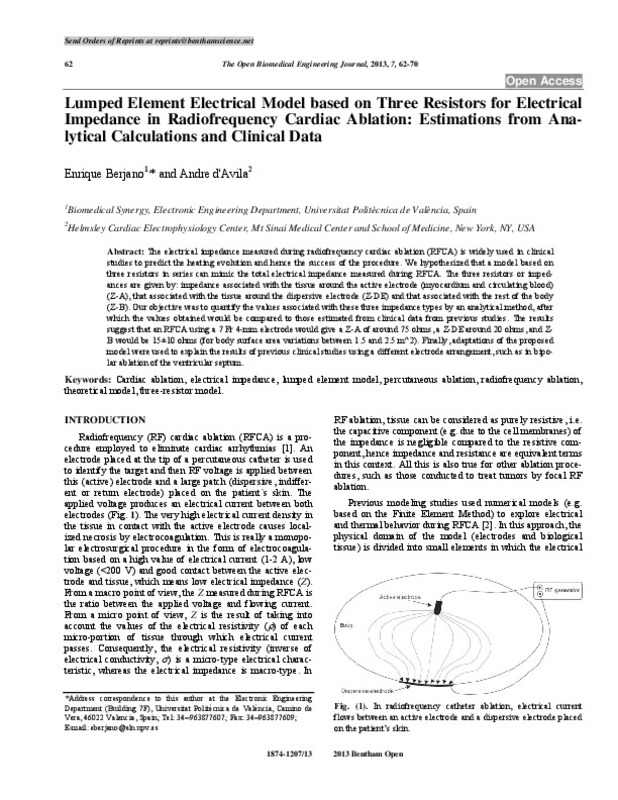Nath S, Haines D E. “Biophysics and pathology of catheter energy delivery systems” Prog Cardiovasc Dis 1995 January-February; 37 : 185-204.
Berjano E J. “Theoretical modeling for radiofrequency ablation: state-of-the-art and challenges for the future” Biomed Eng Online 2006 April; 5 : 2.
Wittkampf F H, and Nakagawa H. “RF catheter ablation: Lessons on lesions” Pacing Clin Electrophysiol 2006 November; 29 : 1285-97.
[+]
Nath S, Haines D E. “Biophysics and pathology of catheter energy delivery systems” Prog Cardiovasc Dis 1995 January-February; 37 : 185-204.
Berjano E J. “Theoretical modeling for radiofrequency ablation: state-of-the-art and challenges for the future” Biomed Eng Online 2006 April; 5 : 2.
Wittkampf F H, and Nakagawa H. “RF catheter ablation: Lessons on lesions” Pacing Clin Electrophysiol 2006 November; 29 : 1285-97.
Neufeld G R GR. “Principles and hazards of electrosurgery including laparoscopy” Surg Gynecol Obstet 1978 November; 147 : 705-10.
Ragheb T, Riegle S, Geddes L A, and Amin V. “The impedance of a spherical monopolar electrode” Ann Biomed Eng 1992; 20 : 617-27.
Panescu D, Whayne J G, Fleischman S D, Mirotznik M S, Swanson D K, and Webster J G. “Three-dimensional finite element analysis of current density and temperature distributions during radio- frequency ablation” IEEE Trans Biomed Eng 1995 September; 42 : 879-90.
Foster K R, Schwan H P. “Dielectric properties of tissues and biological materials: a critical review” Crit Rev Biomed Eng 1989; 17 : 25-104.
Pearce J A. Electrosurgery. London: Chapman and Hall 1986.
Yamamoto T, and Yamamoto Y. “Electrical properties of the epidermal stratum corneum” Med Biol Eng 1976 March; 14 : 151-8.
Miklavcic D, Pavselj N, Hart F X. “Electric Properties of Tissues” In: Akay M, Ed. Wiley Encyclopedia of Biomedical Engineering. Hoboken: Wiley 2006; pp. 1-14.
Saito M, Nakayama K, Hori M, Fujimori Y. “A fundamental study on the electrodes for cardiac pacemakers” Jpn J Med Electron Biol Eng 1967; 5 : 192-8.
Nsah E, Berger R, Rosenthal L, et al. “Relation between impedance and electrode temperature during radiofrequency catheter ablation of accessory pathways and atrioventricular nodal reentrant tachycardia” Am Heart J 1998 November; 136 : 844-51.
Wen Z C, Chen S A, Chiang C E, et al. “Temperature and impedance monitoring during radiofrequency catheter ablation of slow AV node pathway in patients with atrioventricular node reentrant tachycardia” Int J Cardiol 1996 December; 57 : 257-63.
Strickberger S A, Hummel J, Gallagher M, et al. “Effect of accessory pathway location on the efficiency of heating during radiofrequency catheter ablation” Am Heart J 1995 January; 129 : 54-8.
Strickberger S A, Vorperian V R, Man K C, et al. “Relation between impedance and endocardial contact during radiofrequency catheter ablation” Am Heart J 1994 August; 128 : 226-9.
Cao H, Tungjitkusolmun S, Choy Y B, Tsai J Z, Vorperian V R, and Webster J G. “Using electrical impedance to predict catheter-endocardial contact during RF cardiac ablation” IEEE Trans Biomed Eng 2002 March; 49 : 247-3.
Rodriguez L M, Nabar A, Timmermans C, and Wellens H J. “Comparison of results of an 8-mm split-tip versus a 4-mm tip ablation catheter to perform radiofrequency ablation of type I atrial flutter” Am J Cardiol 2000 January; 85 : 109-12.
Sacher F F, O'Neill M D, Jais P, et al. “Prospective randomized comparison of 8-mm gold-tip, externally irrigated-tip and 8-mm platinum- iridium tip catheters for cavotricuspid isthmus ablation” J Cardiovasc Electrophysiol 2007 July; 18 : 709-13.
Jackman W M, Wang X Z, Friday K J, et al. “Catheter ablation of atrioventricular junction using radiofrequency current in 17 patients. Comparison of standard and large-tip catheter electrodes” Circulation 1991 May; 83 : 1562-76.
Nath S, DiMarco J P, Gallop R G, McRury I D, and Haines D E. “Effects of dispersive electrode position and surface area on electrical parameters and temperature during radiofrequency catheter ablation” Am J Cardiol 1996 April; 77 : 765-7.
Santoro I, Xunzhang W, McClelland J, et al. “Effect of skin-patch location and surface area on impedance during radiofrequency catheter ablation” Pacing Clin Electrophysiol 1992; 15 : 580.
Borganelli M, el-Atassi R, Leon A, et al. “Determinants of impedance during radiofrequency catheter ablation in humans” Am J Cardiol 1992 April; 69 : 1095-7.
Park J K, Halperin B D, Kron J, Holcomb S R, and Silka M J. “Analysis of body surface area as a determinant of impedance during radiofrequency catheter ablation in adults and children” J Electrocardiol 1994 October; 27 : 329-32.
Wang D, Hulse J E, Walsh E P, and Saul J P. “Factors influencing impedance during radiofrequency ablation in humans” Chin Med J (Engl) 1995 June; 108 : 450-5.
Koruth J S, Dukkipati S, Miller M A, Neuzil P, d'Avila A, and Reddy V Y. “Bipolar irrigated radiofrequency ablation: a therapeutic option for refractory intramural atrial and ventricular tachycardia circuits” Heart Rhythm 2012 December; 9 : 1932-41.
[-]









